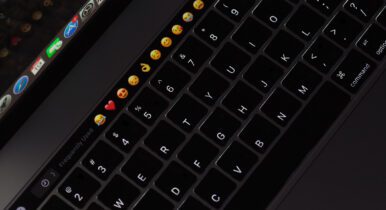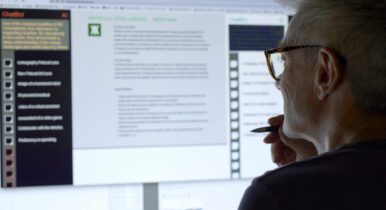One Designer Sees the Left as Understaffed When it Comes to Creative

Tyler Evans got his start in political design after another career pivot didn’t work out. Unemployed with a three-month-old baby at home back in 2014, he saw a job opening online and decided to try his luck in-person at the Wendy Davis campaign office a mile and a half from his home in Fort Worth.
He crashed a field meeting in the process and was suspected of being a Republican plant, but after a series of interviews he landed his first campaign job for the Democrats’ coordinated effort in Texas that year.
That led to a job with American Bridge 21st Century and later Sen. Bernie Sanders’ 2020 presidential primary run. Now, he’s the design director for the senator’s political arm, known as Friends of Bernie Sanders.
C&E: Do you see a popular design trend on the left this cycle?
Evans: I don’t know that I see a big trend at the moment. I see kind of like micro trends here and there. I see people doing some of the stuff that we do with Bernie: textures and slab fonts and just really kind of in-your-face visuals — like real world stuff coming into a digital space. But I haven’t seen a whole lot happening trend-wise that I can really point to, unfortunately. And I think that’s kind of an offshoot of the fact that there’s not a lot of dedicated designers this cycle. It’s just kind of disappointing. Our industry didn’t really spend or dedicate the resources as they did in 2020 with design. That’s a big concern.
C&E: What’s your advice to campaigns right now? Is it hiring a freelancer? Is it bringing someone in on staff?
Evans: I think it’s having somebody on staff — the earlier the better. For the 2020 campaign for Bernie, we were on staff, I think, at the tail end of month two. So we were pretty early on the ground with the campaign as one of the first sections of the digital social media team that was brought on. Every other primary campaign had a design person dedicated, or at least someone whose role was largely design. So I’m a big fan of in-house.
Agencies, God bless them, they do great work. But there’s just something that’s a little bit better having someone in-house who can be dynamic and flexible and catch stuff in the moment and knows the candidate’s style and flare. Someone on an agency may not be privy to that just because they’re not 24/7 on that person all the time as a client. So I would always be in favor of hiring one, if not two people for every federal campaign. Maybe not every House race, because I know that their resources are a little more sparse. But definitely Senate, presidential and even most gubernatorials would be smart to invest in design as a dedicated role.
C&E: Who’s winning the design race this cycle?
Evans: I think that conservatives and Republicans kind of have a leg up on design in some spaces from Democrats and have definitely been a little bit better in some instances in the design and collateral space, which is worrying and concerning.Their side and their campaign committees [have designers working] year round, more so than our folks do. Not every Democrat and leadership [committee] has designers on staff or has a design focus in their digital media approach. But I can tell you for a fact that Rick Scott’s people do, and the NRSC definitely has a pretty heavy visual hand. And there are definitely some Republicans in the House that put visuals pretty front and center.
Democrats everywhere could definitely take a lesson and just reminder that there’s always votes to be won [online], and design is always a part of that. The [social media platforms’] algorithm, on the organic side, have favored static, organic content over video for well over a year and a half, maybe even two years now. I think it would be smart for everyone to invest in someone to capture that and capitalize on it.
C&E: How do you recommend a designer capture a candidate’s personality in their design?
Evans: Getting to know how they speak, the things that they care about, where they’re from — there’s a lot of really rich visual history just in locality. Gubernatorial campaigns usually do a pretty good job of drawing in a lot of local references. Think of your candidate as a human being and what they care about and where they come from first and let that kind of influence everything rather than kind of looking over someone else’s shoulder and copying off their worksheet.It’s gonna be a lot more true and authentic and probably just a lot more interesting to look at in such a crowded media landscape, especially now that everyone has some access to some kind of graphic design.
C&E: Tell us about your team and workflow on the Sanders campaign.
Evans: On the digital media front, it’s myself doing all of the design and some of the social writing — I’d say about half of it — and then our communications director who also does a little bit of the digital writing. And then we have a video director and we have another person who produces our live streams and that’s it for the digital media infrastructure.
It’s a really small team. So a lot of the concepting is like me and our communications director workshopping ideas. I’ll send them a few drafts and we kind of kick it from there. Sometimes you get [approvals from] the political director if it’s in support of a particular candidate just to make sure like the visuals [are] on point and everything matches up. But we kind of steer our own ship in that regard.
C&E: Where are you drawing inspiration from to keep the Sanders brand fresh?
Evans: It’s more music related things or other actual protest art from around the world. I look at a lot of stuff from the Labour Party over in England, Australia and Scotland — the stuff that they do is really inspirational. But as far as American political design, there’s not really much that I look to as far as inspiration in that space.
C&E: What inspired those event posters you’ve been tweeting out?
Evans: We just started looking at the traditional kind of design approaches and what the materials look like to support the messages of Franklin Roosevelt and the Democratic Party. We also took a lot of cues from Lyndon Johnson’s reelection campaign after JFK passed away. And we took a lot of visual cues from the 1930s Democratic Party and the 1960s Democratic Party.
That’s where the majority of it comes from because when you boil down the messaging of Senator Sanders, especially when he was running for president, it’s really just a return of power to the people and the return of the federal [government] to work in favor of working-class people instead of just serving corporate interests and billionaires.
C&E: Are you tracking the metrics on this creative?
Evans: There’s a lot of attention paid to how things do, how things perform, what messaging works, what message maybe doesn’t hit as hard. That includes visuals and aesthetics and how we present the messaging and how we present the brand and just the kind of the vibe as it were of Bernie and what he’s trying to say.
And I’ve noticed that as we’ve kind of slowly [moved] into this territory with our visuals, there’s just been kind of a jump for people in their enthusiasm and their responses.
C&E: I know you said you’re not following trends, but is there a campaign you think is doing design well at this point in the cycle?
Evans: You know who’s doing this pretty good right now is the Fetterman campaign [in Pennsylvania]. They really know their guy, they know his politics, they know his region, they know where he is running. They know who they’re looking to bring to the polls and everything from top to bottom — from his videos to his tweets, to the style of the visuals, everything matches.



